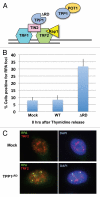RPA and POT1: friends or foes at telomeres?
- PMID: 22373525
- PMCID: PMC3318101
- DOI: 10.4161/cc.11.4.19061
RPA and POT1: friends or foes at telomeres?
Abstract
Telomere maintenance in cycling cells relies on both DNA replication and capping by the protein complex shelterin. Two single-stranded DNA (ssDNA)-binding proteins, replication protein A (RPA) and protection of telomere 1 (POT1) play critical roles in DNA replication and telomere capping, respectively. While RPA binds to ssDNA in a non-sequence-specific manner, POT1 specifically recognizes singlestranded TTAGGG telomeric repeats. Loss of POT1 leads to aberrant accumulation of RPA at telomeres and activation of the ataxia telangiectasia and Rad3-related kinase (ATR)-mediated checkpoint response, suggesting that POT1 antagonizes RPA binding to telomeric ssDNA. The requirement for both POT1 and RPA in telomere maintenance and the antagonism between the two proteins raises the important question of how they function in concert on telomeric ssDNA. Two interesting models were proposed by recent studies to explain the regulation of POT1 and RPA at telomeres. Here, we discuss how these models help unravel the coordination, and also the antagonism, between POT1 and RPA during the cell cycle.
Figures


Similar articles
-
TERRA and hnRNPA1 orchestrate an RPA-to-POT1 switch on telomeric single-stranded DNA.Nature. 2011 Mar 24;471(7339):532-6. doi: 10.1038/nature09772. Epub 2011 Mar 13. Nature. 2011. PMID: 21399625 Free PMC article.
-
A Shld1-controlled POT1a provides support for repression of ATR signaling at telomeres through RPA exclusion.Mol Cell. 2010 Nov 12;40(3):377-87. doi: 10.1016/j.molcel.2010.10.016. Mol Cell. 2010. PMID: 21070964 Free PMC article.
-
Distinct functions of POT1 at telomeres.Mol Cell Biol. 2008 Sep;28(17):5251-64. doi: 10.1128/MCB.00048-08. Epub 2008 Jun 2. Mol Cell Biol. 2008. PMID: 18519588 Free PMC article.
-
POT1-TPP1 telomere length regulation and disease.Comput Struct Biotechnol J. 2020 Jul 3;18:1939-1946. doi: 10.1016/j.csbj.2020.06.040. eCollection 2020. Comput Struct Biotechnol J. 2020. PMID: 32774788 Free PMC article. Review.
-
POT1 mutations cause differential effects on telomere length leading to opposing disease phenotypes.J Cell Physiol. 2023 Jun;238(6):1237-1255. doi: 10.1002/jcp.31034. Epub 2023 May 14. J Cell Physiol. 2023. PMID: 37183325 Review.
Cited by
-
Guardians of the Genome: How the Single-Stranded DNA-Binding Proteins RPA and CST Facilitate Telomere Replication.Biomolecules. 2024 Feb 22;14(3):263. doi: 10.3390/biom14030263. Biomolecules. 2024. PMID: 38540683 Free PMC article. Review.
-
Administration of a Nucleoside Analog Promotes Cancer Cell Death in a Telomerase-Dependent Manner.Cell Rep. 2018 Jun 5;23(10):3031-3041. doi: 10.1016/j.celrep.2018.05.020. Cell Rep. 2018. PMID: 29874588 Free PMC article.
-
RPA-like single-stranded DNA-binding protein complexes including CST serve as specialized processivity factors for polymerases.Curr Opin Struct Biol. 2023 Aug;81:102611. doi: 10.1016/j.sbi.2023.102611. Epub 2023 May 26. Curr Opin Struct Biol. 2023. PMID: 37245465 Free PMC article. Review.
-
RPA engages telomeric G-quadruplexes more effectively than CST.Nucleic Acids Res. 2023 Jun 9;51(10):5073-5086. doi: 10.1093/nar/gkad315. Nucleic Acids Res. 2023. PMID: 37140062 Free PMC article.
-
Single strand DNA binding proteins 1 and 2 protect newly replicated telomeres.Cell Res. 2013 May;23(5):705-19. doi: 10.1038/cr.2013.31. Epub 2013 Mar 5. Cell Res. 2013. PMID: 23459151 Free PMC article.
References
Publication types
MeSH terms
Substances
Grants and funding
LinkOut - more resources
Full Text Sources
Miscellaneous
